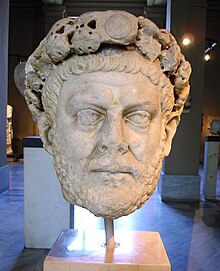Emperor Diocletian
| Diocletian | |||||
|---|---|---|---|---|---|

Laureate head of Diocletian
|
|||||
| 51st Emperor of the Roman Empire | |||||
| Reign | 20 November 284 – July 285 (in competition with Carinus) July 285 – 1 April 286 (alone) 1 April 286 – 1 May 305 (as Augustus of the east, with Maximian as Augustus of the west) |
||||
| Predecessor | Carinus | ||||
| Successor | Constantius Chlorus and Galerius | ||||
| Born | c. 22 December 244 Salona (now Solin, Croatia) |
||||
| Died | 3 December 312 (aged 67) Aspalathos (now Split, Croatia) |
||||
| Burial | Diocletian's Palace in Aspalathos. His tomb was later turned into a Christian church, the Cathedral of St. Domnius, which is still standing within the palace at Split. | ||||
| Spouse | Prisca | ||||
| Issue | Valeria | ||||
|
|||||
| Full name | |
|---|---|
| Diocles (full name unknown) (from birth to accession); Caesar Gaius Aurelius Valerius Diocletianus Augustus (as emperor) |
Diocletian (/ˌdaɪ.əˈkliːʃən/; Latin: Gaius Aurelius Valerius Diocletianus Augustus), born Diocles (244–312), was a Roman emperor from 284 to 305. Born to a family of low status in the Roman province of Dalmatia, Diocletian rose through the ranks of the military to become cavalry commander to the Emperor Carus. After the deaths of Carus and his son Numerian on campaign in Persia, Diocletian was proclaimed emperor. The title was also claimed by Carus' other surviving son, Carinus, but Diocletian defeated him in the Battle of the Margus. Diocletian's reign stabilized the empire and marks the end of the Crisis of the Third Century. He appointed fellow officer Maximian as Augustus, co-emperor, in 286.
Diocletian delegated further on 1 March 293, appointing Galerius and Constantius as Caesars, junior co-emperors. Under this 'tetrarchy', or "rule of four", each emperor would rule over a quarter-division of the empire. Diocletian secured the empire's borders and purged it of all threats to his power. He defeated the Sarmatians and Carpi during several campaigns between 285 and 299, the Alamanni in 288, and usurpers in Egypt between 297 and 298. Galerius, aided by Diocletian, campaigned successfully against Sassanid Persia, the empire's traditional enemy. In 299 he sacked their capital, Ctesiphon. Diocletian led the subsequent negotiations and achieved a lasting and favorable peace.
...
Wikipedia
